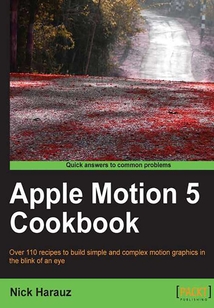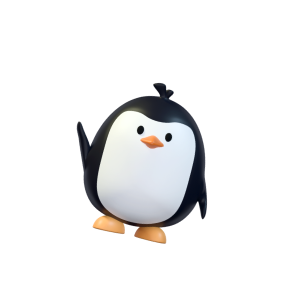舉報 

會員
Apple Motion 5 Cookbook
Nick Harauz 著
更新時間:2021-08-20 17:02:57
開會員,本書免費讀 >
最新章節:
Index
Step-by-step,practicalrecipestobuildsimpleandcomplexMotionGraphicswithMotion5AppleMotion5CookbookisdesignedforFinalCutProXvideoeditorsandMotion5userslookingtogainmoreknowledgeofhowMotionworks,andtogetmoreofa‘WOW’factorinprojects.It’salsoaimedatdesignersandmotiondesignersalike,whoarelookingtobuildontheirskillsets.
最新章節
- Index
- Saving a template
- Exporting using Compressor
- Exporting an alpha channel and video separately
- Exporting a still image and image sequence
- Exporting to DVD
品牌:中圖公司
上架時間:2021-08-20 16:48:50
出版社:Packt Publishing
本書數字版權由中圖公司提供,并由其授權上海閱文信息技術有限公司制作發行
- Index 更新時間:2021-08-20 17:02:57
- Saving a template
- Exporting using Compressor
- Exporting an alpha channel and video separately
- Exporting a still image and image sequence
- Exporting to DVD
- Exporting a full-resolution copy of your project
- Creating your own project presets
- Changing your background color and safe zones
- Introduction
- Chapter 12. Customization and Exporting
- Combining a slider checkbox and pop-up rig – part 3
- Combining a slider checkbox and pop-up rig – part 2
- Combining a slider checkbox and pop-up rig – part 1
- Publishing parameters versus publishing rigs 101 – part 2
- Publishing parameters versus publishing rigs 101 – part 1
- Creating a transition for FCP X
- Creating an effect for FCP X
- Publishing a Motion 5 generator and its parameters to FCP X
- Opening and changing text from FCP X in Motion
- Introduction
- Chapter 11. Publishing Your Work to FCP X
- Turning on Depth of Field
- Creating reflections
- Let's add some light
- Using the Framing camera behavior
- Integrating 3D and 2D
- Adjust Around
- Where am I again? Controlling the view of your world using viewports
- Moving a camera versus moving a layer
- Making it 3D
- Introduction
- Chapter 10. Intro to 3D
- The Pleasantville effect
- Advanced green screen techniques
- Keying a green screen
- Luma-keying a logo
- Match Move Four Corner
- Offset tracking
- Analyze and Match Move
- Stabilizing a clip
- Introduction
- Chapter 9. Motion Tracking and Keying
- Faking 3D extrusion with shapes
- Creating your own video wall
- Adding a camera to interact with your replicator
- Making it 3D! Looking at 3D options for replicators
- Working with replicator presets
- Keyframing the replicator's parameters
- Working with the Sequence Replicator behavior
- Tweaking replicator parameters in the Inspector
- Creating a replicator and changing parameters in the HUD
- Introduction
- Chapter 8. Replicators – It's No Fun By Yourself
- Creating your own Bokeh
- Creating a tunnel through the frame effect
- Working with and manipulating multiple cells
- Using an image sequence in a particle emitter
- Working with particle presets in 3D
- Working with particle presets
- Working with particle behaviors
- Adding randomness values
- Tweaking particle parameters in the Inspector
- Making particles and changing values in the HUD
- Introduction
- Chapter 7. Let's Make Particles
- Creating an advanced logo effect with shapes and masks
- Using image masks
- Applying multiple masks to an image and changing mask modes
- Adding a video to a television screen
- Creating a garbage matte for a green screen
- Using shape masks
- The relationship between shapes and Paint
- Using Sequence Paint
- Changing Shape Style and Width Over Stroke
- Using the Paint Stroke tool
- Introduction
- Chapter 6. Paint and Masks
- Creating a lower third for FCP X
- Using videos and textures to fill text
- Using vector images from the Special Characters library
- Saving your favorite text animations and styles
- Using the Transform Glyph tool
- Sequence Text
- Adding and trimming multiple text behaviors
- Changing the layout and creating text on a path
- Changing the text style
- Changing the text format
- Introduction
- Chapter 5. Let's Make Text
- Combining keyframes and behaviors – animating a clock
- Combining keyframes and behaviors – animating a Photoshop file
- Converting behaviors into keyframes
- Understanding and changing the interpolation
- Reversing keyframes
- Moving keyframes in the Keyframe Editor
- Working with multiple parameters in the Keyframe Editor
- Autokeyframing multiple parameters on a shape
- Keyframing a group
- Deleting and disabling keyframes
- Moving a still's anchor point and keyframing its scale
- Introduction
- Chapter 4. Making It Move with Keyframes
- Holding and looping your animations
- Creating constant and variable speed changes
- Writing on your shape's outline
- An intro to Text behaviors
- Using the Link behavior
- Stop Wriggle Rate and Quantize
- Creating Random Motion using the Randomize behavior
- Adding Edge Collision and Gravity behaviors to a ball
- Adding an Attractor and Attracted To behavior
- Spinning and throwing a ball
- Customizing a Motion Path
- Applying a Fade In/Fade Out and Grow/Shrink behavior to a still
- Introduction
- Chapter 3. Making It Move with Behaviors
- Adding a Flourish and applying filters
- Adding a frame and changing a drop zone's content
- Applying a blend mode to a gradient
- Customizing a gradient generator
- The power of blend modes
- The power of cloning
- Controlling the filter order
- Copying filters and applying filters to a group
- Applying a Glow filter to a layer
- Importing files from the Content library
- A brief tour of the Library tab
- Introduction
- Chapter 2. Looking at Motion's Library
- Managing the Layers tab
- Sequencing stills in the Timeline
- Looking under the hood – key preferences for your workflows
- Keyboard customization
- Launching and customizing a template
- Moving and trimming layers in the Timeline and the mini-Timeline
- Making changes in the Properties tab HUD and Canvas
- Groups versus layers
- Changing the layer order
- Making selections with Expose
- Importing Photoshop and Illustrator files
- Importing files to the Canvas Layers tab and Timeline
- Choosing a Motion project
- Introduction
- Chapter 1. Getting Around the Interface
- Preface
- www.PacktPub.com
- About the Reviewers
- Acknowledgement
- About the Author
- Credits
- 版權信息
- 封面
- 封面
- 版權信息
- Credits
- About the Author
- Acknowledgement
- About the Reviewers
- www.PacktPub.com
- Preface
- Chapter 1. Getting Around the Interface
- Introduction
- Choosing a Motion project
- Importing files to the Canvas Layers tab and Timeline
- Importing Photoshop and Illustrator files
- Making selections with Expose
- Changing the layer order
- Groups versus layers
- Making changes in the Properties tab HUD and Canvas
- Moving and trimming layers in the Timeline and the mini-Timeline
- Launching and customizing a template
- Keyboard customization
- Looking under the hood – key preferences for your workflows
- Sequencing stills in the Timeline
- Managing the Layers tab
- Chapter 2. Looking at Motion's Library
- Introduction
- A brief tour of the Library tab
- Importing files from the Content library
- Applying a Glow filter to a layer
- Copying filters and applying filters to a group
- Controlling the filter order
- The power of cloning
- The power of blend modes
- Customizing a gradient generator
- Applying a blend mode to a gradient
- Adding a frame and changing a drop zone's content
- Adding a Flourish and applying filters
- Chapter 3. Making It Move with Behaviors
- Introduction
- Applying a Fade In/Fade Out and Grow/Shrink behavior to a still
- Customizing a Motion Path
- Spinning and throwing a ball
- Adding an Attractor and Attracted To behavior
- Adding Edge Collision and Gravity behaviors to a ball
- Creating Random Motion using the Randomize behavior
- Stop Wriggle Rate and Quantize
- Using the Link behavior
- An intro to Text behaviors
- Writing on your shape's outline
- Creating constant and variable speed changes
- Holding and looping your animations
- Chapter 4. Making It Move with Keyframes
- Introduction
- Moving a still's anchor point and keyframing its scale
- Deleting and disabling keyframes
- Keyframing a group
- Autokeyframing multiple parameters on a shape
- Working with multiple parameters in the Keyframe Editor
- Moving keyframes in the Keyframe Editor
- Reversing keyframes
- Understanding and changing the interpolation
- Converting behaviors into keyframes
- Combining keyframes and behaviors – animating a Photoshop file
- Combining keyframes and behaviors – animating a clock
- Chapter 5. Let's Make Text
- Introduction
- Changing the text format
- Changing the text style
- Changing the layout and creating text on a path
- Adding and trimming multiple text behaviors
- Sequence Text
- Using the Transform Glyph tool
- Saving your favorite text animations and styles
- Using vector images from the Special Characters library
- Using videos and textures to fill text
- Creating a lower third for FCP X
- Chapter 6. Paint and Masks
- Introduction
- Using the Paint Stroke tool
- Changing Shape Style and Width Over Stroke
- Using Sequence Paint
- The relationship between shapes and Paint
- Using shape masks
- Creating a garbage matte for a green screen
- Adding a video to a television screen
- Applying multiple masks to an image and changing mask modes
- Using image masks
- Creating an advanced logo effect with shapes and masks
- Chapter 7. Let's Make Particles
- Introduction
- Making particles and changing values in the HUD
- Tweaking particle parameters in the Inspector
- Adding randomness values
- Working with particle behaviors
- Working with particle presets
- Working with particle presets in 3D
- Using an image sequence in a particle emitter
- Working with and manipulating multiple cells
- Creating a tunnel through the frame effect
- Creating your own Bokeh
- Chapter 8. Replicators – It's No Fun By Yourself
- Introduction
- Creating a replicator and changing parameters in the HUD
- Tweaking replicator parameters in the Inspector
- Working with the Sequence Replicator behavior
- Keyframing the replicator's parameters
- Working with replicator presets
- Making it 3D! Looking at 3D options for replicators
- Adding a camera to interact with your replicator
- Creating your own video wall
- Faking 3D extrusion with shapes
- Chapter 9. Motion Tracking and Keying
- Introduction
- Stabilizing a clip
- Analyze and Match Move
- Offset tracking
- Match Move Four Corner
- Luma-keying a logo
- Keying a green screen
- Advanced green screen techniques
- The Pleasantville effect
- Chapter 10. Intro to 3D
- Introduction
- Making it 3D
- Moving a camera versus moving a layer
- Where am I again? Controlling the view of your world using viewports
- Adjust Around
- Integrating 3D and 2D
- Using the Framing camera behavior
- Let's add some light
- Creating reflections
- Turning on Depth of Field
- Chapter 11. Publishing Your Work to FCP X
- Introduction
- Opening and changing text from FCP X in Motion
- Publishing a Motion 5 generator and its parameters to FCP X
- Creating an effect for FCP X
- Creating a transition for FCP X
- Publishing parameters versus publishing rigs 101 – part 1
- Publishing parameters versus publishing rigs 101 – part 2
- Combining a slider checkbox and pop-up rig – part 1
- Combining a slider checkbox and pop-up rig – part 2
- Combining a slider checkbox and pop-up rig – part 3
- Chapter 12. Customization and Exporting
- Introduction
- Changing your background color and safe zones
- Creating your own project presets
- Exporting a full-resolution copy of your project
- Exporting to DVD
- Exporting a still image and image sequence
- Exporting an alpha channel and video separately
- Exporting using Compressor
- Saving a template
- Index 更新時間:2021-08-20 17:02:57


